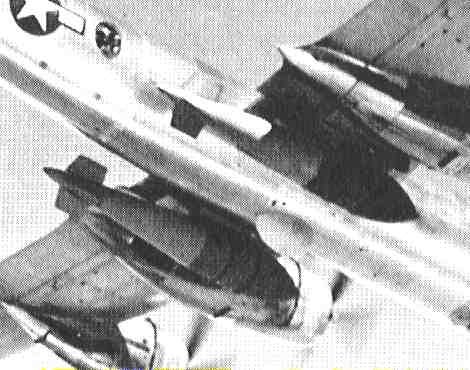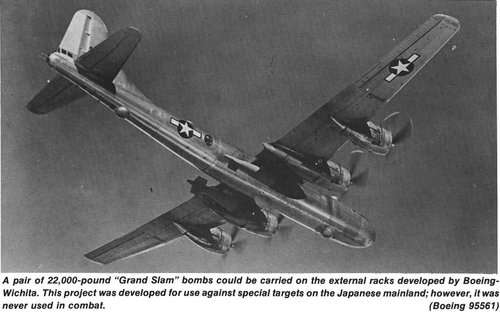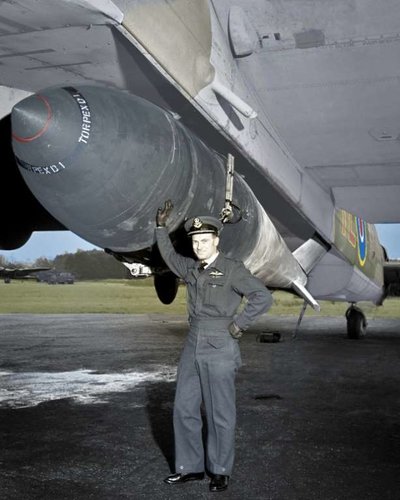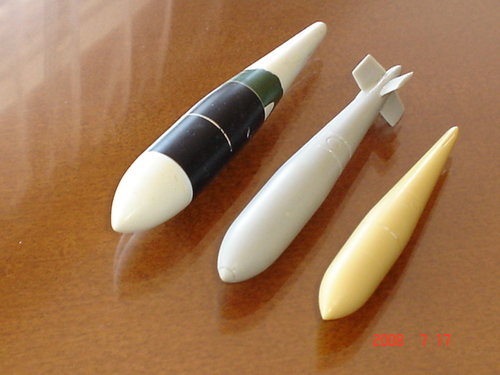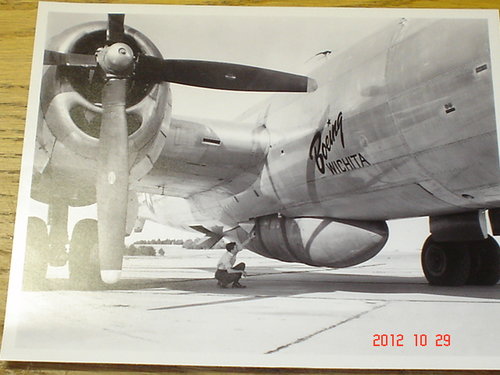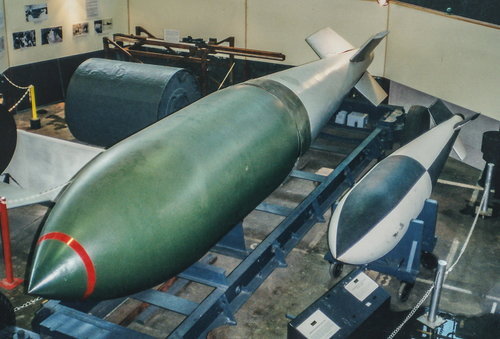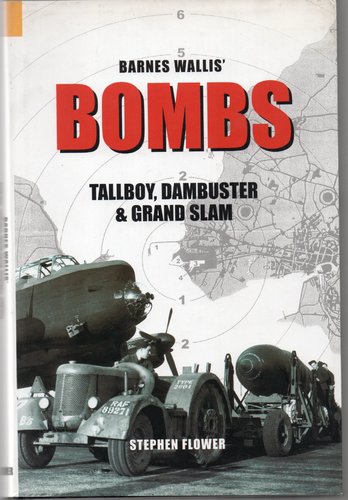I've looked thru every B-29 book I have or have seen & Googled with no luck. I've read that some of the B-29s sent to the RAF were equipped with racks at the wing roots to carry a Grand Slam bomb under each wing. ISTR also that some USAF a/c were modified as well. I've not been able to find pics or drawings of this installation or use of. Does anyone know if this practice was actually done? Has anyone ever come across any drawings or info? Thanks.
You are using an out of date browser. It may not display this or other websites correctly.
You should upgrade or use an alternative browser.
You should upgrade or use an alternative browser.
RAF Boeing Washington B.1 (B-29) with Grand Slam bombs
- Thread starter frank
- Start date
-
- Tags
- cold war early 1950s free fall nuclear bombs free fall nuclear weapons heavy bomber korean war late 1940s mutual defense assistance act mutual defense assistance program north atlantic treaty organisation nuclear battlefield raf bomber command royal air force strategic bomber united states united states air force
- Joined
- 3 June 2011
- Messages
- 18,347
- Reaction score
- 12,264
Thanks!
sferrin said:this would be the page you're looking for but it looks like all the pictures got pulled.
http://members.aol.com/nukeinfo2/
B-29 with two Tall Boys. (From that page.)
Vahe Demirjian
I really should change my personal text
- Joined
- 28 February 2013
- Messages
- 815
- Reaction score
- 570
There's an image of a B-29 Superfortress with Grand Slam bombs at the following link:
this would be the page you're looking for but it looks like all the pictures got pulled.
B-29 with two Tall Boys. (From that page.)
Actually, those are two Grand Slams. I've got a number of photos from the Boeing Archive (with licenses) and one of them shows a B-29 with a T.12 mounted (which is a bomb twice as heavy as a Grand Slam) A way to tell what bomb is being carried is by the number of chains holding the bomb to the rack, two chains means a Grand Slam. The B.29 could carry a Tall boy internally.
I've got a high resolution photo of that picture from Boeing, when you look it over with a magnifying glass, there's a guy's face looking out that side bubble window, clear as day ---
You'll notice the notch in the trailing edge of the flap there too ---
As an aside, my Dad served in 617 squadron during the period that they were using the Grand Slam, reason for my interest in the bomb.
The nice thing about using the B-29 was it could get to the height that Barnes Wallace had designed the bombs to be dropped at.
You'll notice the notch in the trailing edge of the flap there too ---
As an aside, my Dad served in 617 squadron during the period that they were using the Grand Slam, reason for my interest in the bomb.
The nice thing about using the B-29 was it could get to the height that Barnes Wallace had designed the bombs to be dropped at.
Coincidentally, this news article just came up on Microsoft News. I live near Calgary.
- Joined
- 26 January 2011
- Messages
- 2,226
- Reaction score
- 645
Coincidentally, this news article just came up on Microsoft News. I live near Calgary.
Interesting picture attached. It appears to show a Tall Boy attached externally to, I assume a Lancaster?
Coincidentally, this news article just came up on Microsoft News. I live near Calgary.
Interesting picture attached. It appears to show a Tall Boy attached externally to, I assume a Lancaster?
I don't see any Tall Boy in the article
- Joined
- 19 July 2016
- Messages
- 4,287
- Reaction score
- 3,466
Tallboy had modified doors while the Grand slam had the doors removed and modifications to allow the fuselage to be cleared on release.
- Joined
- 16 April 2008
- Messages
- 9,613
- Reaction score
- 14,518
I downloaded the image K_M refers to
.View attachment 616731
The caption on this photo says it's a Grand Slam, not a Tall Boy.
This is the photo of the T.12 slung under a B-29. Notice the fairing on the underside of the wing root where the spars had to be re-enforced to take the weight.
EDIT: Photo was provided by Boeing Archives with a license which doesn't restrict me where I use it.
EDIT: Photo was provided by Boeing Archives with a license which doesn't restrict me where I use it.
Attachments
Last edited:
nuuumannn
Cannae be ar*ed changing my personal text
- Joined
- 21 October 2011
- Messages
- 276
- Reaction score
- 547
I don't have a picture of real one together,
I took this many years ago at Brooklands Museum - scanned from a 35mm photo. Unfortunately the bombs are now no longer in such a photogenic arrangement, although they are together in the same building. You can really appreciate the difference in size between the Tall Boy and the Grand Slam when they are together.
Attachments
Dilandu
I'm dissatisfied, which means, I exist.
Were there any interest from RAF to VB-13 Tarzon guidance kits for Tallboys?
I don't have a picture of real one together,
I took this many years ago at Brooklands Museum - scanned from a 35mm photo. Unfortunately the bombs are now no longer in such a photogenic arrangement, although they are together in the same building. You can really appreciate the difference in size between the Tall Boy and the Grand Slam when they are together.
The bomb with the black and white markings isn’t a 12,000lb Tallboy but a 4,000lb Tallboy Small created in late 1943 to test the concept. It just serves to emphasise the size of Grand Slam.
Brooklands Museum :: Login
Brooklands have examples of all the Barnes Wallis bombs.
nuuumannn
Cannae be ar*ed changing my personal text
- Joined
- 21 October 2011
- Messages
- 276
- Reaction score
- 547
The bomb with the black and white markings isn’t a 12,000lb Tallboy but a 4,000lb Tallboy Small created in late 1943 to test the concept. It just serves to emphasise the size of Grand Slam.
Thanks for that, Ewen.
Brooklands have examples of all the Barnes Wallis bombs.
Indeed it does, although the last time I was there two years ago, I only saw the Grand Slam and Tall Boy Small on display near each other in the stratosphere chamber building.
Thanks for posting that EwenS, I was going to say that's more of a comparison between a Tallboy and T12. Would you know if there was any plans to put Tallboy Small into service ?
According to “A Hell of a Bomb” by Stephen Flower the Tallboy Small was designed to prove the ballistics as a step up from firing miniatures from a gun down a gypsum mine and before moving on to produce Tallboy (or Tallboy Medium) and Grand Slam (or Tallboy Large).
One thing learned from the first drops of the 4000lb version was the need to angle the fins to generate spin and improve accuracy. Only 12 were manufactured with the first drop was in Dec 1943 by the AAEE, operating from Boscombe Down, using the range at Orfordness. More tests with them were made in April 1944.
The odd thing is that the 22000 pounder was designed first, then scaled down to 4000lb for the test articles and 12000lb.
Flower’s book was later republished as
Barnes Wallis' Bombs: Tallboy, Dambuster and Grand Slam (Revealing History): Amazon.co.uk: Flower, Stephen: 9780752429878: Books
Buy Barnes Wallis' Bombs: Tallboy, Dambuster and Grand Slam (Revealing History) New Edition by Flower, Stephen (ISBN: 9780752429878) from Amazon's Book Store. Everyday low prices and free delivery on eligible orders.
www.amazon.co.uk
Thanks Ewen, my Dad served in 617 sqn from 1944 to 46, he was interested into anything related like that but I don't remember him mentioning anything about the Tallboy Small so I was very interested in it. I'll keep an eye out for that book too.
What I have read about the Grand Slam it was scaled down because the Lancaster couldn't get it up to the altitude Wallis design it to be dropped at, somewhere around 30-35,000ft. The B-29 tests showed what it could really do when dropped from that altitude.
What I have read about the Grand Slam it was scaled down because the Lancaster couldn't get it up to the altitude Wallis design it to be dropped at, somewhere around 30-35,000ft. The B-29 tests showed what it could really do when dropped from that altitude.
taildragger
You can count on me - I won a contest
- Joined
- 2 November 2008
- Messages
- 404
- Reaction score
- 502
I wonder how it was intended that the B-29 would drop the twin Tall Boy load in combat.
- If dropped simultaneously, I'd think that the detonation of the first to hit might impair the effectiveness of the second. They could be configured to separate during the fall, but that would reduce accuracy.
- If the drop was staggered, aircraft motion after release of the 1st 22,000 lb. bomb would complicate aiming of the 2nd.
- If dropped simultaneously, I'd think that the detonation of the first to hit might impair the effectiveness of the second. They could be configured to separate during the fall, but that would reduce accuracy.
- If the drop was staggered, aircraft motion after release of the 1st 22,000 lb. bomb would complicate aiming of the 2nd.
Last edited:
AIUI the only operational outfit was with the 19th BG in Korea using single Tarzon bombs. Anything else was purely an experimental fit. That would allow a reduced fuel load to keep total weight within the B-29 max take off weight of 135,000lb.
SleeperService2
Not sure about changing it now.
- Joined
- 16 August 2016
- Messages
- 70
- Reaction score
- 97
Reading through this thread and looking at the photos I'm struggling to see how the wings would support the Tallboys, and the fuel, and the normal bombload, and the turrets/guns/gunners. Is there any evidence of the wing root modifications applied to the T-12 carrier? As that beast weighed about twice as much as Grand Slam would the double carriage of same need the same strengthening. Has anybody found any paperwork to provide more information on this project.I've got a high resolution photo of that picture from Boeing, when you look it over with a magnifying glass, there's a guy's face looking out that side bubble window, clear as day ---
You'll notice the notch in the trailing edge of the flap there too ---
As an aside, my Dad served in 617 squadron during the period that they were using the Grand Slam, reason for my interest in the bomb.
The nice thing about using the B-29 was it could get to the height that Barnes Wallace had designed the bombs to be dropped at.
To my mind using bomb bay tanks and part filling the wing tanks seems the only way this might work. It's interesting to note the T/O and landing weights in the S.A.C HERE landing weight limited by strength nearly the same as T/O limited by space.
That would allow a reduced fuel load to keep total weight within the B-29 max take off weight of 135,000lb.
The Characteristics summary HERE shows 140 000lbs as MTOW performance limited, the lower figure is space restricted so a little more to play with.
Dilandu
I'm dissatisfied, which means, I exist.
AIUI the only operational outfit was with the 19th BG in Korea using single Tarzon bombs. Anything else was purely an experimental fit. That would allow a reduced fuel load to keep total weight within the B-29 max take off weight of 135,000lb.
Yep, the USAF were skeptical about RAF idea of "very-very precise bomb drop"; they argued that in non-ideal condition it's just too hard for average crew to achieve, and highly-trained special mission squadrons are not practical in cost-effective terms. So, the idea of installing RAZON tail guidance kit (with enlarged rudders) on Tallboy was suggested. Albeit the rudders weren't still big enough, so the circular wing was added during testing, to provide aerodynamic lifting force in any desired direction of turn.
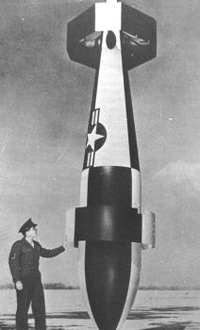
- Joined
- 9 October 2009
- Messages
- 21,979
- Reaction score
- 13,645
On a sad note:

 www.telegraph.co.uk
www.telegraph.co.uk
Rest In Peace.


Squadron Leader ‘Benny’ Goodman, one of the last surviving bomber pilots of 617 (Dambuster) Squadron – obituary
Goodman dropped Barnes Wallis’s powerful Tallboy bomb on the battleship Tirpitz and the 22,000 lb Grand Slam which destroyed a viaduct
Squadron Leader ‘Benny’ Goodman, one of the last surviving bomber pilots of 617 (Dambuster) Squadron – obituary
Squadron Leader Lawrence “Benny” Goodman, who has died aged 100, was one of the last two surviving Lancaster pilots of 617 (Dambuster) Squadron who were involved in attacking the German battleship Tirpitz in late 1944. And in the final weeks of the war he dropped the 22,000 lb “Grand Slam”, the biggest bomb dropped by the RAF.
Goodman had completed his training as a bomber pilot in the summer of 1944 when he was posted to 617 Squadron, based at Woodhall Spa in Lincolnshire. With its unique reputation as a special-duties squadron manned by highly experienced crews, it was unusual for a novice crew to be sent to 617.
Rest In Peace.
pathology_doc
ACCESS: Top Secret
- Joined
- 6 June 2008
- Messages
- 1,587
- Reaction score
- 1,510
Based on reading Brickhill's "The Dam Busters", the thing they found is that both Tallboy and Grand Slam were capable of doing everything that was originally desired from the concept, even though the Lanc couldn't get it up to Wallis's ideal drop height.What I have read about the Grand Slam it was scaled down because the Lancaster couldn't get it up to the altitude Wallis design it to be dropped at, somewhere around 30-35,000ft. The B-29 tests showed what it could really do when dropped from that altitude.
- Joined
- 5 May 2007
- Messages
- 1,483
- Reaction score
- 2,860
Logically, once you're dropping from high enough to reach terminal velocity, all extra altitude does is increase the time available for wind to push the bomb off course.Based on reading Brickhill's "The Dam Busters", the thing they found is that both Tallboy and Grand Slam were capable of doing everything that was originally desired from the concept, even though the Lanc couldn't get it up to Wallis's ideal drop height.What I have read about the Grand Slam it was scaled down because the Lancaster couldn't get it up to the altitude Wallis design it to be dropped at, somewhere around 30-35,000ft. The B-29 tests showed what it could really do when dropped from that altitude.
NARA II, COLLEGE PARK |
SECRET
ADDRESS REPLY TOCOMMANDING GENERAL, ARMY AIR FORCES
WASHINGTON 25. D.C.
HEADQUARTERS, ARMY AIR FORCES
WASHINGTON
WASHINGTON
5 JAN 1945
MEMORANDUM FOR: The Commanding General, Army Air Forces.
SUBJECT: Report of Conference on Large Bombs for AAF Bombardment Aircraft.
1. A meeting was held at this headquarters on 3 January 1945, to determine course of action necessary to facilitate carrying of British or AAF large size bombs in bombardment aircraft. (List of conferees is attached.)
2. Current and recently contracted bombardment aircraft have bomb bays designed to carry the maximum number of 500 pound American bombs with provisional requirement for carrying the 4,000 pound bomb and recently the 10,000 L.C. American bomb.
3. To extend the suitability of our bombardment aircraft to carry even larger bombs than the above, all existing and contemplated aircraft were evaluated. The British 12,000 and 22,000 pound bombs and a theoretical American 44,000 pound bomb were considered.
4. The following action is recommended:
a. B-29
(1) One article now being modified at Bell, Marietta, will be tested by AAF Board. If satisfactory results are obtained, all B-29 aircraft will be modified to accommodate one 12,000 pound G.P. British “tall boy” bomb.
b. B-32(2) Present study for carrying the 22,000 pound “Grand Slam” British bomb will be completed to the extent required to determine the feasibility of this installation.
(1) The B-32 has its bomb bay compartment divided into cells which will accommodate bombs no larger than 4,000 pounds. Enlargement of these cells to handle large size bombs would entail basic redesign of fuselage structure.
c. XB-35 (Flying Wing)(2) Air Technical Service Command is to instigate a study to determine the extent of redesign necessary to the fuselage to carry the 12,000 or 22,000 pound bombs.
(1) The 12,000 and 22,000 pound bombs are too large to fit between the wing spars which determine the length of the bomb bay.
d. B-36(2) This airplane now carries eight (8) 4,000 pound bombs.
(1) This model will have its design changed to accommodate any of the following bomb loads:
(a) Two (2) of the largest possible bombs which are estimated to be in the order of 44,000 pounds each. The Ordnance is to build this bomb.
(b) Two (2) 22,000 pound.
e. XB-45 (North American Jet Medium Bomber)(c) Two (2) 12,000 pound.
(1) This model will be redesigned to accommodate the 22,000 pound bomb.
f. XB-46 (Consolidated Jet Medium Bomber)(2) Bomb bay space is now sufficient to accommodate one (1) 10,000 or one (1) 12,000 pound bomb.
(1) As designed it has space for one (1) 12,000 pound bomb,
g. XB-47 (Boeing Jet Medium Bomber)(2) The 22,000 pound bomb installation will be studied.
(1) The airplane will be redesigned to accommodate one (1) 12,000 pound bomb.
h. XB-48 (Martin Jet Bomber)(2) The 22,000 pound bomb installation will be studied.
5. A military requirements policy will be formulated to govern bomb load requirements for future bombardment designs. This policy will insure consideration of bombs of the sizes discussed above.(1) Present design will be modified and Martin will be instructed to provide a design which will carry either one (1) 22,000 or one (1) 12,000 pound bomb.
/S/
O.P. ECHOLS,
Major General, U. S. A.,
Ass’t Chief of Air Staff,
Materiel and Services.
O.P. ECHOLS,
Major General, U. S. A.,
Ass’t Chief of Air Staff,
Materiel and Services.
Incl:
List of conferees at meeting 3 Jan. 45.
COORDINATION:
OC&R – Dr
– – – – – – – – – – – – – – – – – – – – – – – – – – – – – – – –
CONFERENCE LIST
CONFERENCE LIST
The following listed persons attended conference at this Headquarters in the Office of AC/AS, Materiel & Services on 3 January 1945, to formulate plans for modification or redesign of existing and content-plated AAF bombardment aircraft to accommodate the British "Grand Slam" (22,000 lb.) and "Tall Boy" (12,000 lb.) bombs:
NAME | REPRESENTING |
| Maj. Gen. O.P. Echols | AC/AS, M&S |
| Brig. Gen. E.M. Powers | AC/AS, M&S |
| Brig. Gen. R.C. Coupland | AC/AS, M&S |
| Brig. Gen. Donald Wilson | AC/AS, OC&R |
| Brig. Gen. F.O. Carroll | ATSC |
| Brig. Gen. L.C. Craigie | ATSC |
| Colonel J.F. Phillips | AC/AS, M&S |
| Colonel J.G. Moore | AC/AS, M&S |
| Colonel J.H. Wallace | AC/AS, OC&R |
| Colonel F.R. Cook | ATSC |
| Colonel R.E. Jarmon | ATSC |
| Colonel A.P. Taber | ATSC |
| Colonel R.G. Butler, Jr. | ORDNANCE |
| Lt. Colonel J.A. Gibbs | AC/AS, M&S |
| Lt. Colonel J.M. Gruitch | AC/AS, M&S |
| Lt. Colonel E. Elliott, Jr. | AC/AS, M&S |
| Lt. Colonel G.J. Fix, Jr. | AC/AS, OC&R |
| Lt. Colonel D.E. Bailey | AC/AS, OC&R |
| Major W.H. Jones, Jr. | AC/AS, M&S |
| Captain R.S. Williams | ATSC |
| Captain R.L. Roark | ATSC |
- Joined
- 9 October 2009
- Messages
- 21,979
- Reaction score
- 13,645
Scott Kenny
ACCESS: USAP
- Joined
- 15 May 2023
- Messages
- 11,668
- Reaction score
- 14,386
Emphasis mine. That wouldn't be a bad thing, except for the sheer size of the first generation nukes needing larger bomb bays...
(deleted for space)
3. To extend the suitability of our bombardment aircraft to carry even larger bombs than the above, all existing and contemplated aircraft were evaluated. The British 12,000 and 22,000 pound bombs and a theoretical American 44,000 pound bomb were considered.
4. c. XB-35 (Flying Wing)
(1) The 12,000 and 22,000 pound bombs are too large to fit between the wing spars which determine the length of the bomb bay.
(2) This airplane now carries eight (8) 4,000 pound bombs.
And would have let the B-35s carry second generation atomic bombs pretty easily.
Similar threads
-
Development of Airborne Armament 1910-1961
- Started by RyanC
- Replies: 3
-
US speculation on a rudimentary Indian nuclear bomber force in 1972
- Started by datafuser
- Replies: 5
-
-
-

